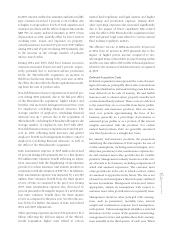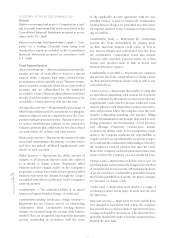American Express 2004 Annual Report Download - page 65
Download and view the complete annual report
Please find page 65 of the 2004 American Express annual report below. You can navigate through the pages in the report by either clicking on the pages listed below, or by using the keyword search tool below to find specific information within the annual report.
The carrying value of the CDOs, as well as derivatives
recorded on the balance sheet as a result of consolidating
certain SLTs which are in the process of being liquidated,
and AEFA’s projected return are based on discounted
cash flow projections that require a significant degree of
management judgment as to assumptions primarily
related to default and recovery rates of the high-yield
bonds and/or bank loans either held directly by the CDOs
or in the reference portfolio of the SLTs and, as such, are
subject to change. Although the exposure associated with
AEFA’s investment in CDOs is limited to the carrying
value of such investments, they have significant volatility
associated with them because the amount of the initial
value of the loans and/or other debt obligations in the
related portfolios is significantly greater than AEFA’s
exposure. In the event of significant deterioration of a
portfolio, the relevant CDO may be subject to early liq-
uidation, which could result in further deterioration of the
investment return or, in severe cases, loss of the CDO car-
rying amount. The derivatives recorded as a result of con-
solidating and now liquidating certain SLTs under FIN 46
are primarily valued based on the expected gains and
losses from liquidating a reference portfolio of high-yield
loans. As previously mentioned, the exposure to loss
related to these derivatives is represented by the pretax
net assets of the SLTs, which is $462 million at
December 31, 2004. Deterioration in the value of the ref-
erence portfolio would likely result in deterioration of the
consolidated derivative value.
AEFA holds reserves for current and future obligations
that are primarily related to fixed annuities, investment
certificates and life and health insurance. Reserves for
fixed annuities, universal life contracts and investment
certificates are equal to the underlying contract accu-
mulation values. Reserves for other life and
health insurance products are based on various
assumptions, including mortality rates, morbidity rates
and policy persistency.
Separate account assets represent funds held for the
exclusive benefit of variable annuity and variable life
insurance contract holders. These assets are generally
carried at market value, and separate account liabilities
are equal to separate account assets. AEFA earns invest-
ment management, administration and other fees from
the related accounts. Separate account assets increased
in 2004 due to net market appreciation, foreign cur-
rency translation impacts and net inflows.
The National Association of Insurance Commissioners
(NAIC) has prescribed Risk-Based Capital (RBC)
requirements for insurance companies. The RBC
requirements are to be used as minimum capital and
surplus requirements by the NAIC and state insurance
regulators to identify companies that merit further
regulatory attention.
At December 31, 2004, each of AEFA’s insurance com-
panies had adjusted capital and surplus in excess of
amounts requiring such attention.
In addition to regular quarterly dividends, AEFA paid
special dividends of $930 million to the Parent Com-
pany during 2004.
State insurance statutes also contain limitations as to
the amount of dividends and distributions that insurers
may make without providing prior notification to
state regulators. For IDS Life, any dividends or dis-
tributions in 2005, whose amount, together with that
of other distributions made within the preceding 12
months, exceeds IDS Life’s 2004 statutory net gain
from operations, would require notification to the
Minnesota Commissioner of Commerce who would
have the option to disapprove the proposed distribu-
tion based on consideration of general solvency as well
as RBC requirements.
For discussion of the rating agency response to the pro-
posed spin-off of AEFA, see Note 23 to the Consoli-
dated Financial Statements.
Contingent Liquidity Planning
AEFA has developed a contingent funding plan that
enables it to meet daily customer obligations during
periods in which its customers do not roll over matur-
ing certificate contracts and elect to withdraw funds
from their annuity and insurance contracts. This plan is
designed to ensure that AEFA could meet these cus-
tomer withdrawals by selling or obtaining financing,
through repurchase agreements, of portions of its
investment securities portfolio.
AXP
AR.04
63
Financial Review
























